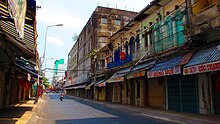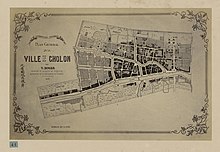Chợ Lớn
| Chợ Lớn | |||||||||||||||
|---|---|---|---|---|---|---|---|---|---|---|---|---|---|---|---|
 Bình Tây Market in Chợ Lớn | |||||||||||||||
| Chinese name | |||||||||||||||
| Chinese | ĐêNgạn[1][2] | ||||||||||||||
| Literal meaning | embankment | ||||||||||||||
| |||||||||||||||
| Vietnamese name | |||||||||||||||
| Vietnamese Alpha bet | Chợ Lớn | ||||||||||||||
| Hán-Nôm | 𢄂𡘯[3] | ||||||||||||||
Chợ Lớn(,Chinese:Bờ đê), usually anglicized as "Cholon"in English sources, is a quarter ofHo Chi Minh City,Vietnam.It lies on the west bank of theSaigon River,havingBình Tây Marketas its central market. Chợ Lớn consists of the western half ofDistrict 5as well as several adjoining neighborhoods inDistrict 6andDistrict 11.The quarter has long been inhabited by Chinese people and is considered the largestChinatownin the world by area.[citation needed]
The Vietnamese name Chợ Lớn literally means "big" (lớn) "market" (chợ). The Chinese (and original) name isĐêNgạn(In Cantonese,tai4 ngon6,which is occasionally rendered in Vietnamese orthography asThầy NgònorThì Ngòn,[4]and in Mandarin,Dī'àn),[1][2]which means "embankment" (French:quais). The Sino-Vietnamese reading of the Chinese name isĐê Ngạn,but this is rarely used. Vietnamese speakers exclusively use the nameChợ Lớn,while Chinese speakers (both inside Vietnam and in China) are the only users of the original Chinese name.
History
[edit]
The city of Chợ Lớn was established by theHoacommunity. TheLê dynastywhich was the ruling family in the sixteenth century began to decline in power and two rival families, theTrịnhandNguyễnfamilies began to vie for power to fill in the void of the Lê. The Nguyễn lords were then appointed as Viceroy of the South with headquarters atHuếwhere they encouraged Chinese immigration to settle down into the area.[5]
In 1778, Hoa people living inBiên Hòa(mostly in City Isle;Cù lao PhốofHiệp Hòa wardnowadays) had to take refuge in what is now Chợ Lớn because they were retaliated against by theTây Sơnforces for their support of theNguyễn lords.In 1782, more than 10,000 Hoa people were again massacred by the Tây Sơn and had to rebuild.[6]They built high embankments against the flows of the river and called their new settlementTai-Ngon(Đê ngạn;meaning "embankment" in Cantonese).


Chợ Lớn was incorporated as a city in 1879, 11 kilometers (6.8 mi) from Saigon. By the 1930s, it had expanded to the city limit of Saigon. On April 27, 1931, Chợ Lớn and the neighboring city of Saigon were merged to form a single city calledSaigon–Cholon.The official name, however, never entered everyday vernacular and the city continued to be referred to asSaigon."Cholon"was dropped from the city's official name in 1956, after Vietnam gained independence from France in 1955.[7]
During theVietnam War,soldiers and deserters from the United States Army maintained a thrivingblack marketat Chợ Lớn, trading in various American and especially U.S. Army-issue items. This was the area, near theQuan Âm Pagodawhere photojournalistEddie Adamstook his famous execution photograph.[8]Four Australian journalists were also killed in Chợ Lớn during theTet Offensivein 1968.[9]
Today, Chợ Lớn attracts many tourists, especiallymainland ChineseandTaiwanese.
Notable residents
[edit]- Yvon Petra- He was born in Chợ Lớn. He is best remembered as the last Frenchman to win the Wimbledon championships men's singles title in 1946.
- Cao Văn Viên- Chief of the Joint General Staff of theArmy of the Republic of Vietnamfrom 1966 to 1975.[10][11]
- Gontran de Poncins- French author, aristocrat, and adventurer lived here in 1955. He resided in the Sun Wah hotel, keeping an illustrated journal that was published asFrom a Chinese City(published in 1957). "He chose Cho Lon, the Chinese riverbank community snuggled up to Saigon because he suspected the ancient customs of a national culture endure longer in remote colonies than in the motherland. In effect, he was studying a bit of ancient China."[12]
- Charles Tran Van Lam
- Wan Kwong(Chinese: Doãn quang ), born Lui Minkwong ( Lữ minh quang and also known as Jackson Wan Kwong), Hong Kong singer
Temples and monuments
[edit]
- Quan Am Temple( Quan Âm chùa )
- Thien Hau Temple (Cholon)
- Cho Lon Mosque
- Nhị Phủ Temple ( nhị phủ miếu )
- Hà Chương (Hokkien) Guildhall
- Miếu Quan Đế ( Quan Đế miếu )
- Minh HươngGuildhall ( minh hương gia thịnh hội quán )
- Tam Sơn Guildhall ( tam sơn hội quán )
External links
[edit]- .Encyclopædia Britannica.Vol. 6 (11th ed.). 1911. p. 267.
- literatier Ulrich Brinkhoff: Albträume am Saigon-Fluss. Agenda 2014,ISBN978-3-89688-516-6.
book contains many situations and photos in Cholon (in German)
References
[edit]- ^ab"Bờ đê —— toàn cầu lớn nhất phố người Hoa ( tổ đồ ) - quốc tế tại tuyến - tin tức trung tâm".
- ^ab"Thành phố Hồ Chí Minh bờ đê khu: Tiếng Quảng Đông thông hành" tiểu Hong Kong "".Archived fromthe originalon October 4, 2013.RetrievedNovember 15,2015.
- ^"Cholon, Ho Chi Minh City - the Vietnam Guide".thevietnamguide.Archived fromthe originalon April 25, 2012.
- ^"Bảo tàng Lịch sử Quốc gia".Vietnam National Museum of History(in Vietnamese).RetrievedJanuary 19,2022.
- ^Socio-Economic Background of the Hoa People(PDF)(Thesis). Shodhganga. p. 34.
- ^Socio-Economic Background of the Hoa People(PDF)(Thesis). Shodhganga. p. 34.
- ^P. 61,Historic Dictionary of Ho Chi Minh City(written by Justin Corfield; published by Anthem Press in 2013)
- ^Faber, John (1978).Great News Photos and the Stories Behind Them.Courier Dover Publications. p. 136.ISBN9780486236674.
- ^Colebatch, Hal G.P. (October 30, 2009)."The Saigon media slaughter".The Australian.RetrievedNovember 6,2013.
- ^St. George, Donna. "Cao Van Vien, 1921-2008."Washington Post.January 2, 2009.
- ^Kinnard, Douglas.The War Managers: American Generals Reflect on Vietnam.Reprint ed. Cambridge, Massachusetts: Da Capo Press, 1991.ISBN0-306-80449-2
- ^Book product description.
